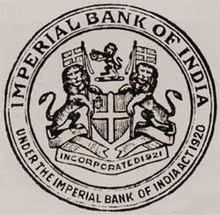State Bank of India (
SBI) is a multinational
banking and financial services company based in India. It is agovernment-owned corporation with its headquarters in Mumbai, Maharashtra. As of December 2013, it had assets of
US$388 billion and 17,000 branches, including 190 foreign offices, making it the largest banking and financial services company in India by assets.
State Bank of India is one of the Big Four banks of India, along with ICICI Bank, Punjab National Bank andHDFC Bank.
The bank traces its ancestry to
British India, through the Imperial Bank of India, to the founding, in 1806, of the Bank of Calcutta, making it the oldest commercial bank in the Indian Subcontinent. Bank of Madrasmerged into the other two "presidency banks" in British India, Bank of Calcutta and Bank of Bombay, to form the Imperial Bank of India, which in turn became the State Bank of India. Government of India owned the Imperial Bank of India in 1955, with Reserve Bank of India (India's Central Bank) taking a 60% stake, and renamed it the State Bank of India. In 2008, the government took over the stake held by the Reserve Bank of India.
State Bank of India is a regional banking behemoth and has 20% market share in deposits and loans among Indian commercial banks.
[5]History

Seal of
Imperial Bank of India.
The roots of the State Bank of India lie in the first decade of the 19th century, when the Bank of Calcutta, later renamed theBank of Bengal, was established on 2 June 1806. The Bank of Bengal was one of three Presidency banks, the other two being the Bank of Bombay (incorporated on 15 April 1840) and the Bank of Madras (incorporated on 1 July 1843). All three Presidency banks were incorporated as joint stock companies and were the result of royal charters. These three banks received the exclusive right to issue paper currency till 1861 when, with the Paper Currency Act, the right was taken over by the Government of India. The Presidency banks amalgamated on 27 January 1921, and the re-organised banking entity took as its name Imperial Bank of India. The Imperial Bank of India remained a joint stock company but without Government participation.
Pursuant to the provisions of the State Bank of India Act of 1955, the Reserve Bank of India, which is India's central bank, acquired a controlling interest in the Imperial Bank of India. On 1 July 1955, the Imperial Bank of India became the State Bank of India. In 2008, the government of India acquired the Reserve Bank of India's stake in SBI so as to remove any conflict of interest because the RBI is the country's banking regulatory authority.
In 1959, the government passed the State Bank of India (Subsidiary Banks) Act, which made eight state banks associates of SBI. A process of consolidation began on 13 September 2008, when the State Bank of Saurashtra merged with SBI.
SBI has acquired local banks in rescues. The first was the Bank of Bihar (est. 1911), which SBI acquired in 1969, together with its 28 branches. The next year SBI acquired National Bank of Lahore (est. 1942), which had 24 branches. Five years later, in 1975, SBI acquired Krishnaram Baldeo Bank, which had been established in 1916 in Gwalior State, under the patronage of Maharaja Madho Rao Scindia. The bank had been the
Dukan Pichadi, a small moneylender, owned by the Maharaja. The new bank's first manager was Jall N. Broacha, a Parsi. In 1985, SBI acquired the Bank of Cochin in
Kerala, which had 120 branches. SBI was the acquirer as its affiliate, the State Bank of Travancore, already had an extensive network in Kerala.
The State Bank of India and all its associate banks are identified by the same blue keyhole logo. The State Bank of India wordmark usually has one standard typeface, but also utilises other typefaces.
On October 7, 2013, Arundhati Bhattacharya became the first woman to be appointed Chairperson of the bank.
0 comments:
Post a Comment